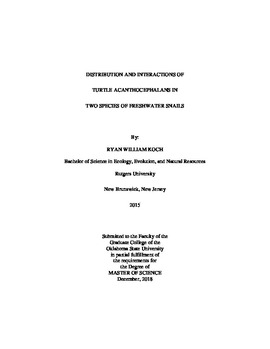| dc.description.abstract | Acanthocephalans are an understudied group of parasites, with only 8% of their life cycles know. Nevertheless, acanthocephalans are a very complex group of organisms, parasitizing all classes of vertebrates from terrestrial, freshwater, and marine habitats. One interesting component in acanthocephalan life cycles is the addition of a paratenic host, which bridges an ecological gap between the intermediate and definitive hosts. Of all paratenic host records, approximately 99% are vertebrates, leaving only a few reports of acanthocephalans in invertebrates. Interestingly, freshwater snails have been reported as paratenic hosts for a species of turtle acanthocephalan, Neoechinorhynchus emydis. However, very little is known regarding these snail-acanthocephalan interactions and the importance of snails in acanthocephalan life cycles. The objectives of this thesis were to examine two common species of freshwater snails, Helisoma trivolvis and Physa acuta, for acanthocephalans in northcentral Oklahoma. Specifically, I conducted spatial and temporal snail surveys for acanthocephalans and used molecular techniques to identify acanthocephalans to species. Additionally, I investigated acanthocephalan pathology in snails with the use of lifespan experiments and histology. These data indicate that acanthocephalan prevalence and intensity in snails vary strongly in time and space, with H. trivolvis being the more commonly infected snail host. Based on complete ITS rDNA sequences, juvenile acanthocephalans in snails were 100% identical to adult N. emydis from turtles. Acanthocephalans did not significantly have an impact on snail survival, whereas trematodes and snail size did. Lastly, results from field infection experiments indicate that snails are not acquiring acanthocephalan infections during the winter, which may be a result of the absence of infected ostracod intermediate hosts or the crashing snail populations in the winter. This was the first comprehensive survey on the distribution of acanthocephalans in snail hosts and suggests that snails commonly use a turtle acanthocephalan in their life cycle. These observations strongly suggest that N. emydis may be more common in snail paratenic hosts than the current lack of reports suggests, and snails may play an important role in the transmission of N. emydis to turtle definitive hosts that reside in wetland habitats. | |
